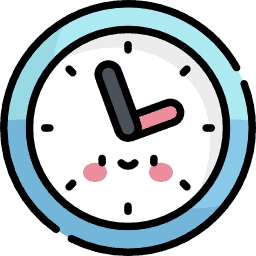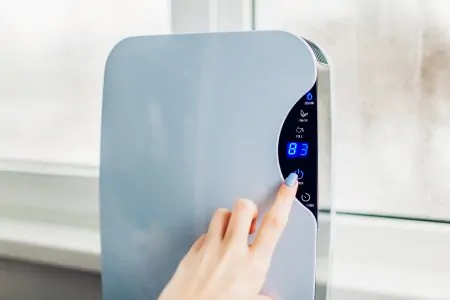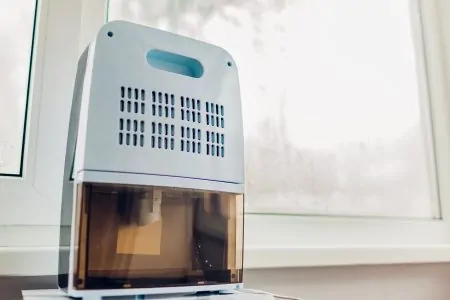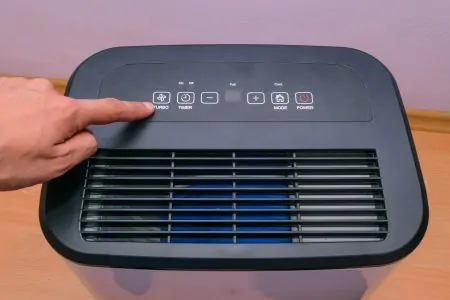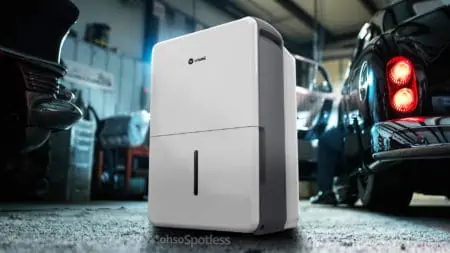High humidity can cause a room to become clammy, musty, and overall uncomfortable. Not to mention, high levels of humidity will cause dampness and excess moisture that can lead to mold, mildew, and other bacteria. Consequently, it can be terrible for your health.
Luckily, there are many ways to improve your home environment and get that humidity to calm down. We’ll show you how to dehumidify a room using eight different but effective methods.
Key Takeaways
- High humidity can lead to mold, mildew, and health issues in your home.
- Effective ways to dehumidify a room include using rock salt, DampRid, or a dehumidifier.
- Improving air circulation with fans or air conditioning can also reduce humidity.
- To maintain a healthy humidity level, aim for 30-60% relative humidity in your home.
How to Dehumidify a Room
How to dehumidify a room depends on the size of the room and how humid it is. We’ve found and tested some popular and effective ways to successfully lower the humidity in a room. Some methods are cheap and quick, while others require more effort.
Rock Salt
Rock salt is a natural hygroscopic material that absorbs moisture and stores it — similarly to dehumidifiers. However, rock salt is completely natural, non-toxic, and requires no electricity.
Rock salt is a crystal mined underground and taken to a particular facility. Here, the salt crystals are extracted and sold as we know it. People love to use rock salt as a natural dehumidifier, mainly because it’s affordable and non-toxic.
Quickly construct your own rock salt dehumidifier using two buckets or any other containers. The main requirement is that the two containers are stackable. Here’s how to do it.
1. Drill the Bucket
Start by drilling holes in the bottom of the top bucket. Additionally, you can cut a few holes around the sides of the top bucket.
2. Add Salt
After placing the drilled bucket into the bottom bucket, add enough salt to fill about a quarter of the bucket.
3. Place Strategically
Place your homemade dehumidifier strategically where it can collect the optimal amount of moisture. If available, you can place a fan close to the bucket — the air will help to guide the moisture into the salt trap. As a result, the rock salt will extract moisture from the air and collect it in the bottom bucket.
Pros
- Much more affordable than a dehumidifier.
- Readily available as rock salt is easy to access.
- Easy DIY — all you need is a drill, bucket, and salt.
Cons
- Only suitable for short-term use.
DampRid
DampRid is a product designed to remove moisture from small areas, such as a bedroom, greenhouse, or even RV. It’s available in various forms, including a hanging packet, spreadable powder, and a bucket.
The calcium chloride effectively removes moisture from the air, hardens it, and it eventually becomes a solid mass. Calcium chloride crystals are generally white or overall colorless. However, they can “rust” slightly over time.
DampRid is incredibly affordable and user-friendly — you get to monitor its effectiveness visually. Plus, it doesn’t require any maintenance and creates no mess.
You simply follow the included guidelines on how to use it. Hanging moisture absorbers are excellent for closets and pantries, while the buckets can cover larger areas.
Pros
- Affordable, costing around 10 percent of a humidifier.
- Easy to use — simply place it where you want it and leave it.
- Maintenance-free, no cleaning required.
- They’re effective for up to two months.
Cons
- Requires replacements and refills.
Dri-Z-Air
Dri-Z-Air is another product similar to DampRid. It consists of non-toxic calcium chloride crystals that are effective moisture-absorbers.
Unlike DampRid, Dri-Z-Air is simpler and basically comes as crystals in a large bag or container. They don’t come in different forms, such as hanging absorbers.
However, you can buy a Dri-Z-Air DZA-U Pot, which is made of recycled plastic. You get a 13-ounce refill bag to get started. The pot consists of a top and bottom part — the top contains the crystals, and the bottom collects the water.
As the crystals absorb moisture, they’ll begin to disappear. Once they’re low in counts or completely gone, it’s time to refill.
You can also make your own container. Here’s how:
1. Prepare a Colander
Start by lining a plastic colander with vinyl screening — then fill it with Dri-Z-Air crystals.
2. Grab a Bowl
Find a big bowl or bucket where the colander fits on top. Place it in the bowl or bucket to catch the liquified crystals.
Dri-Z-Air is easy to use, and once all crystals are liquified, all you have to do is dump the contents in the toilet or sink. Because the crystals are non-toxic salts, they’ll merely create a brine that won’t harm the environment or sewer.
Pros
- Non-toxic and eco-friendly formula.
- Easy to use.
- Affordable price point, saving you money on a dehumidifier.
- Great for small enclosed areas like a bathroom or closet.
Cons
- Requires refills which can be costly over time.
Baking Soda
Baking soda creates yummy cupcakes, but it also absorbs moisture. It’s also very affordable, easy to use, and works effectively in smaller rooms or enclosed spaces.
All you have to do is put some baking soda in a bowl or open container. Then place it in a humid room or area, and it will slowly absorb moisture from the air. You can occasionally stir the powder around as it clumps when absorbing moisture.
Tip For Using Baking Soda
Another plus for baking soda is its ability to absorb odors as well. When the humidity is high, and there’s significant dampness, musty odors are likely also present. The baking soda will help to keep the bad odor to a minimum.
Pros
- Affordable (most likely already in your cabinets or pantry).
- Non-toxic and naturally occurring.
- Absorbs odors and removes foul scents from a room.
Cons
- Only effective in small areas.
Dehumidifier
If your home is humid, the most effective way to get rid of the dampness is by using a dehumidifier. Dehumidifiers consist of a small fan, compressor, coils, and refrigerant. They draw air through the fan and then extract moisture by cooling and reheating the air.
The extracted moisture is collected in a bucket or drained through a hose. Dehumidifiers come in various sizes and types — refrigerant (explained above) is the most common. However, desiccant dehumidifiers, like the Ivation Desiccant, are also popular and effective options.
Unlike the natural methods we mentioned above, dehumidifiers must be plugged into an outlet. In addition, they can cover large areas and even a whole house depending on their capacity.
Pros
- Designed to dehumidify a room effectively and quickly.
- Effective in bigger rooms and areas.
- You’re able to control the humidity.
- Available in a range of sizes and types.
Cons
- Uses a significant amount of electricity.
- Requires filters that need washed and replaced.
Fan
If you have standing or ceiling fans in your home, running them throughout the day will improve air circulation. Enclosed rooms are often more humid because the moisture has nowhere to escape. By running a fan and opening a window, you can bring some fresh air in and thereby dehumidify the room.
Pros
- Easy to use with minimal effort.
- Improves the air circulation within a room.
- Your home may already have a fan.
Cons
- Fans can be noisy.
Air Conditioning
Air conditioners work similarly to dehumidifiers as they draw air from the room and cool it. The only difference is that dehumidifiers disperse heated air back into the room while air conditioners dispose of it outside. Consequently, running an air conditioner can help to dehumidify a room.
Some air conditioners are equipped with a dehumidifying function — if yours is, use it when the AC is on. This can also help to save energy as you won’t need a dehumidifier on the side.
Pros
- Effective at dehumidifying a room.
- Cools the air in the meantime.
- Great for summertime — kill two birds with one stone.
Cons
- Uses a significant amount of electricity.
Space Heater
We usually associate humidity with the warm summer months, but it can become quite humid indoors during the winter. Warming your house using dry heat can effectively keep dampness and moisture at bay. A space heater is an excellent dry heat source.
Pros
- Effective during the winter.
- Warms your house as well.
- Space heaters are easy to use.
Cons
- Can be difficult to use around children and pets as they carry a burn risk.
- You can’t leave space heaters unattended.
What Causes Humidity in a Home?
Below, you’ll find a list of some of the most common causes of high humidity in the home and what you can do about it.
1. Bad Ventilation
Poor ventilation is one of the main culprits of high humidity inside the home. We often don’t think about it, but opening a few windows is essential to get a change of air. Let the old humid and damp air run out and get a much-needed breeze going.
Appliances such as washers and dryers will also create a significant amount of humidity. While the appliances are running, work a fan or open a window to let some of the moisture escape.
2. Water Damage
Leaks and water damage are unfortunate, but they happen, especially if your plumbing is old.
The relative humidity will likely be higher if you have a leak somewhere in your house. Consequently, leaving a leak will cause further damage and lead to mold if not fixed and dried quickly. Call a professional for an assessment to find a solution quickly.
3. Indoor Greenery
Having indoor plants is an excellent way to improve air quality. A study by NASA showed that certain species can absorb chemicals and other pollutants such as VOCs (1). While NASA recommends having one plant per 100 square feet for effective results, you may want to rethink this if humidity is an issue.
Plants require water to live. Therefore, having an abundance of greens inside your home will raise the humidity. Consider moving your plants to a balcony or keeping them close to a window.
4. Firewood
Having a fireplace in your home is an effective and cheap way of warming your house — not to mention how cozy it can be on snowy days. However, you may want to reconsider where you store your firewood. You see, wood absorbs moisture, so it can raise the humidity if stored indoors.
Signs of Humidity Problems in the House
Humidity isn’t always bad — too low, and it can be uncomfortable. It’s essential to create a balance. Anything between 30 and 60 percent is best.
However, too much humidity can lead to a few issues for your home and health. Here are a few signs that you have humidity problems in your home:
- Condensation: As you’re staring out the window on a crisp winter morning, you might notice water beading on the glass. This is a tell-tale sign of too much moisture inside your house.
- Mold spots: Mold is the last thing we want to see within the comfort of our homes, but it can happen if the humidity is high. Check the walls, floors, and ceilings for any signs of mold. If you see mold, call a professional for assessment — they can run mold tests to ensure it isn’t black mold.
- Musty odor: If you have excess moisture in your house, a musty odor is likely present. You might notice this in the basement, entrances, garage, and crawl spaces. Dehumidifying your home should help. If not, the musty odor could be a sign of mold.
- Allergies: Dampness has been shown to affect your health, especially if you have allergies or asthma. It can cause respiratory issues with symptoms such as wheezing, coughing, and infections (2).
How to Measure Humidity
The points above show that you have a problem with humidity within your home, but how high is the humidity? It can be good to know just how high it is, especially since it’s recommended to keep the humidity below 60 percent. Luckily, it’s easy to check your exact humidity levels using a hygrometer.
A hygrometer works by measuring the moisture in the air. All you have to do is place the hygrometer in a room to monitor the humidity. You’ll then get a reading of the relative humidity (RH) in percentage.
The relative humidity is the amount of moisture in the air at a specific temperature compared to how much it can hold. In other words, when the relative humidity reaches 100 percent, the air simply can’t hold the vapor anymore (3).
Reasons to Control Humidity
Not only can high levels of humidity be uncomfortable, but it can also cause a few health effects. Here are a few reasons why you’d want to control the humidity in your home:
- Increase in germs: Germs cause infections. Some organisms thrive in warm, humid environments and spread quickly in these conditions. Keeping the humidity low can help to keep them at bay.
- Dust mites: Itchy skin and triggered asthma? You’re probably sharing your bed with dust mites. Dust mites are found within pillows, mattresses, carpets, and upholstery. These microscopic pests thrive in humid conditions and will trigger allergies and asthma. They flourish in humid conditions, so try to keep the indoor humidity below 50 percent (4).
- Mold: Having mold in your home can affect your health in many ways, or not at all. Nevertheless, it’s never wanted indoors as it can trigger allergies and cause headaches, nausea, and red eyes. Keeping your relative humidity between 30 and 60 percent will keep mold at bay (5).
Tips to Help Reduce Humidity
Running a dehumidifier or keeping a bucket of rock salt nearby are effective ways to dehumidify a room. However, sometimes a few simple changes to everyday activities can help maintain a balanced humidity. Try some of the following tips:
- Quick showers: Long hot showers will create dampness throughout your home, causing the humidity to rise. By shortening your showers and lowering the temperature.
- Ventilate your kitchen: Cover your food while cooking or run a fan or exhaust fan.
- Open windows: Keeping windows closed at all times will cause a build-up of humidity. When the outside humidity is low, open a few windows and let some fresh air come inside. You can check the outside humidity online.
- Vent fans: Vent fans are found in the kitchen and bathroom of most homes, but many fail to use them. Make it a habit to run the vent fan in the kitchen while cooking and in the bathroom after showering.
FAQs
Creating a Balance
Healthy living is all about balance — too much humidity is bad, but so is too little. You can improve your health and home environment by creating a balance.
Depending on which method you prefer, there are many effective ways to dehumidify a room. Natural methods such as rock salt and baking soda are excellent for smaller areas, while larger rooms require a dehumidifier or AC.
In addition, it’s essential to look out for humidity issues, such as mold and water beads. Excess moisture and dampness can cause several health issues, such as triggering allergies and respiratory problems. Luckily, a few simple changes to everyday activities can help to keep humidity levels balanced.




